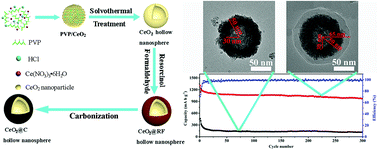当前位置:
X-MOL 学术
›
Inorg. Chem. Front.
›
论文详情
Our official English website, www.x-mol.net, welcomes your
feedback! (Note: you will need to create a separate account there.)
Double-shelled CeO2@C hollow nanospheres as enhanced anode materials for lithium-ion batteries†
Inorganic Chemistry Frontiers ( IF 6.1 ) Pub Date : 2018-11-09 00:00:00 , DOI: 10.1039/c8qi01068d Qinghua Gong 1, 2, 3, 4, 5 , Tingting Gao 1, 2, 3, 4, 5 , Hui Huang 1, 2, 3, 4, 5 , Rongxue Wang 1, 2, 3, 4, 5 , Pei Cao 1, 2, 3, 4, 5 , Guowei Zhou 1, 2, 3, 4, 5
Inorganic Chemistry Frontiers ( IF 6.1 ) Pub Date : 2018-11-09 00:00:00 , DOI: 10.1039/c8qi01068d Qinghua Gong 1, 2, 3, 4, 5 , Tingting Gao 1, 2, 3, 4, 5 , Hui Huang 1, 2, 3, 4, 5 , Rongxue Wang 1, 2, 3, 4, 5 , Pei Cao 1, 2, 3, 4, 5 , Guowei Zhou 1, 2, 3, 4, 5
Affiliation

|
Metal oxide-based nanomaterials are extensively studied as anode materials for lithium-ion batteries (LIBs) because of their high energy densities. However, the practical application of these nanomaterials is hindered by their fast capacity degradation resulting from the large volume expansion upon lithiation. In this work, CeO2@resorcinol and formaldehyde resin (RF) hollow nanospheres were prepared by polymerization of resorcinol and formaldehyde on the CeO2 hollow sphere surface. Mesoporous double-shelled CeO2@C hollow nanospheres were obtained by carbonizing RF in CeO2@RF. The resulting composites display a typical double-shell hollow structure with a cavity diameter of approximately 60 nm. The thickness of the CeO2 layer is approximately 20 nm, and the carbon shell of the outer layer is approximately 15 nm. This double-shelled structure, in which the CeO2 hollow nanospheres are uniformly dispersed inside the carbon nanoshells, can simultaneously act as a conductive framework and a protective buffer layer to restrain volume variations. The fabricated nanospheres exhibit a remarkable electrochemical performance as anodes for LIBs, displaying a high reversible capability (1309.1 mA h g−1 at 100 mA g−1), stable cycling life (903.6 mA h g−1 after 300 cycles at 100 mA g−1), and good rate capacity (761.6 mA h g−1 at 1000 mA g−1). This effective strategy provides new insight into the design and synthesis of other composite electrodes for high-performance lithium-ion batteries.
中文翻译:

双壳CeO 2 @C空心纳米球作为锂离子电池的增强阳极材料†
基于金属氧化物的纳米材料由于其高能量密度而被广泛地研究作为锂离子电池(LIB)的阳极材料。然而,这些纳米材料的实际应用由于其在锂化时的大体积膨胀而导致的快速容量降低而受到阻碍。在这项工作中,通过将间苯二酚和甲醛在CeO 2空心球表面聚合,制备了CeO 2 @间苯二酚和甲醛树脂(RF)中空纳米球。通过在CeO 2 @RF中碳化RF获得中孔双壳CeO 2 @C空心纳米球。所得复合材料显示出典型的双壳中空结构,其空腔直径约为60 nm。CeO 2的厚度层的厚度约为20nm,外层的碳壳约为15nm。这种双壳结构,其中CeO 2空心纳米球均匀地分散在碳纳米壳内部,可以同时充当导电骨架和保护性缓冲层,以抑制体积变化。所制造的纳米球表现出显着的电化学性能作为阳极为LIBS,(1309.1毫安汞柱显示高的可逆能力-1在100mA克-1),稳定的循环寿命(903.6毫安汞柱-1在100mA克300次循环后-1),以及良好的速率容量(761.6毫安汞柱-1以1000mA克-1)。这种有效的策略为高性能锂离子电池的其他复合电极的设计和合成提供了新的见识。
更新日期:2018-11-09
中文翻译:

双壳CeO 2 @C空心纳米球作为锂离子电池的增强阳极材料†
基于金属氧化物的纳米材料由于其高能量密度而被广泛地研究作为锂离子电池(LIB)的阳极材料。然而,这些纳米材料的实际应用由于其在锂化时的大体积膨胀而导致的快速容量降低而受到阻碍。在这项工作中,通过将间苯二酚和甲醛在CeO 2空心球表面聚合,制备了CeO 2 @间苯二酚和甲醛树脂(RF)中空纳米球。通过在CeO 2 @RF中碳化RF获得中孔双壳CeO 2 @C空心纳米球。所得复合材料显示出典型的双壳中空结构,其空腔直径约为60 nm。CeO 2的厚度层的厚度约为20nm,外层的碳壳约为15nm。这种双壳结构,其中CeO 2空心纳米球均匀地分散在碳纳米壳内部,可以同时充当导电骨架和保护性缓冲层,以抑制体积变化。所制造的纳米球表现出显着的电化学性能作为阳极为LIBS,(1309.1毫安汞柱显示高的可逆能力-1在100mA克-1),稳定的循环寿命(903.6毫安汞柱-1在100mA克300次循环后-1),以及良好的速率容量(761.6毫安汞柱-1以1000mA克-1)。这种有效的策略为高性能锂离子电池的其他复合电极的设计和合成提供了新的见识。











































 京公网安备 11010802027423号
京公网安备 11010802027423号